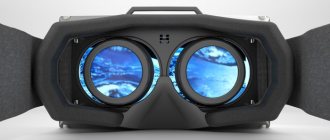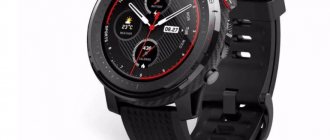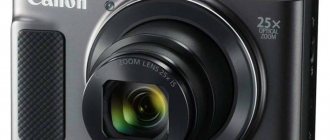13.03.20192304
Virtuality is a magical world created by technical methods, into which the player is immersed through his senses: hearing, sight and touch. For greater realism, the entire process takes place in real time. Today, this industry is only at the stage of development, which is happening very rapidly. Perhaps in just a few years, the virtual world will no longer be distinguishable from the real one. Whether this is good or bad, everyone decides for themselves.
Below you will find the top and review of the 10 best VR glasses for smartphones. The research was carried out according to the price-quality criterion. The presented models are the best-selling and most popular on the market
What is virtual reality
Virtual reality is an artificially created world transmitted to a person through sensations. Although VR devices have boomed in popularity over the past few years (and are still ongoing), the first attempts to create an artificial world were made back in the early 60s of the last century.
Virtual reality is completely artificial and is not connected with the real world, this is its fundamental difference from augmented reality.
Who is the creator
One of the pioneers in the field of virtual reality research is Myron Kruger, an American artist and creator of the first interactive works. In the late 60s, he introduced the very concept of “artificial reality.”
Somewhat earlier, cinematographer Morton Heilig presented the Sensorama simulator. A series of short videos was broadcast to the viewer, accompanied by smells, the wind created by a hairdryer, and the noise of big cities.
The first helmet was described and designed by engineer Ivan Sutherland in 1967. The image for it was generated by a computer. The helmet was equipped with sensors that track head movements, which made it possible to dynamically change the image depending on which direction the user turned his head.
Actually, even then, researchers came to the conclusion that the image for future virtual reality devices would be created by a computer. In the 70s, computer graphics finally replaced films, and the world of virtual reality moved to 3D.
The first head-mounted simulators were not for the consumer market. Pilots were trained on them and in their capabilities they were noticeably inferior to modern models. Hardly anyone thought about gaming devices back then, because the personal computer market did not yet exist.
Long before the first VR devices appeared, artificial reality helmets were described by science fiction writers.
What are VR glasses for?
VR glasses are needed to organize the stereo effect. It is with their help that the illusion of a three-dimensional image is created and this is the main function of VR glasses.
Full VR helmets
The most expensive VR devices are helmets. They are designed for games and are used with additional accessories (cameras, microphones, interactive controllers). The VR headset, depending on its version, provides the highest possible graphics and high-quality light blocking. These helmets have a high-definition screen, are comfortable, can be mounted on the head and are adjustable in size.
You can play by moving around your axis, but for a full experience you need free space, at least 2x2 meters.
Control is carried out using controllers, and each model has its own. Oculus, for example, comes with an Xbox controller, while PS comes with them included with the console. But the main advantage is the motion controllers with which you can play virtual tennis or golf. This is Oculus touch or PlayStation Move. And Sony even presented a prototype controller with palm tracking in May of this year.
The most popular are the Oculus series helmets: Rift S and Quest 2, HTC Vive Pro and Vive Cosmos and PSVR. You should choose the right one depending on the device you are going to play on.
PS VR works with PlayStation 4 and will be compatible with PS 5. This helmet costs from 25 thousand.
There are quite a few exclusive games for PS VR: short releases from PlayStation VR Worlds, narrative game Deracine, shooter game Farpoint, specially designed for the Aim controller in the form of a rifle, horror Resident Evil 7 and many others.
With a helmet on a PC, you can play Half Life: Alyx (first-person shooter), Walking Dead (horror), LA Noire (detective), Star Wars Squadrons (flight simulator) and a huge number of other games. The price of such helmets starts from 45 thousand rubles.
Oculus Quest 2 is in a league of its own. This helmet does not require a PC, although it works with one. The entire system is built-in, and all you need to use is a smartphone, the appropriate application and a Facebook account.
The helmet has 3 degrees of freedom, which means that you can rotate around yourself, but you cannot walk or sit down. The screen resolution of the Quest 2 is Full HD. For comparison, the Chinese counterpart Pico G2 offers 4K. These glasses include the HTC Vive Focus Plus, which supports 5G and is equipped with 6DoF controllers, that is, those that provide movement in three-dimensional space. Oculus Quest costs 50 - 60 thousand, depending on the storage capacity: 64 GB or 256 GB.
The helmet has a special application store. You can play BeatSaber (arcade), Superhot (shooter) and other games without a computer.
digitaltrends.com
What characteristics should a helmet have?
All standalone and PC helmets have several options.
- Resolution: the higher it is, the better.
- Built-in headphones: optional. It all depends on how high-quality sound you prefer. More often than not, gaming headphones sound better.
- Image Frequency: Again, the higher, the smoother the image will be.
- A selection of additional accessories.
- Wearing comfort: It is best to try the helmet in a club and evaluate according to your own preferences.
How they work
The fundamental design of modern helmets is no different from the design of the very first models. Inside the case there is a screen or several screens, in front of which there is a partition and two eyepieces with lenses. The dimensions of helmets are relatively small, so they are often called glasses. However, there are differences. Helmets are equipped with their own displays, while in glasses the role of the display is performed by the smartphone screen.
The helmet design in the classical sense, that is, with a completely closed head, is used mainly in professional models used for training pilots and sailors.
How VR works
Both the cheapest and the most expensive glasses use the same principle. The original picture is split into two separate images for the right and left eyes.
The partition present between the eyepieces allows you to divide a person’s field of vision into two areas. Images for each eye are broadcast alternately, but with high frequency, so the human brain perceives the picture as a single whole. As a result, a flat image becomes three-dimensional. In fact, the stereo effect deceives the brain, but this is enough for a person to feel like he is in virtual reality.
The effect of presence is enhanced by the tracking system. The VR helmet is equipped with sensors (gyroscopes, accelerometers, magnetometers) that allow you to track changes in its position in space. Expensive models also have an IR sensor system that makes tracking more extensive and accurate. The image that a person sees on the internal monitor of the glasses instantly changes depending on which direction and at what angle he looks.
Samsung HMD Odyssey+ virtual reality helmet – Windows Mixed Reality Headset
Photo: https://market.yandex.ru
HMD Odyssey+ is equipped with two 3.5-inch AMOLED displays with a combined resolution of 2880x1600. They're the same as its predecessor, but the new headset's displays feature Anti-Screen Door Effect (Anti-SDE) technology. The so-called “screen door effect” occurs when people see gaps between pixels in headset displays; Samsung says Anti-SDE solves this problem by "using a grid that diffuses the light coming from each pixel and accurately replicates the image in the area around each pixel." “As a result, your eyes perceive ambient light as part of the visual content at a perceived 1.233PPI, which is double the previous generation's already high 616PPI,” Samsung said in a statement.
Samsung HMD Odyssey+ virtual reality helmet – Windows Mixed Reality Headset
Advantages:
- sold at a good discount
- integrated 3D audio
- adjustable lenses
- works with SteamVR
Flaws:
- headphones, front part, back pad not replaceable
- fixed cable
- no hinged lid
Types of VR devices
Despite the similar design and general principle of operation, VR devices are usually divided into helmets and glasses. True, the boundary between them is not always noticeable, especially when comparing wireless glasses for a smartphone with a 3D helmet on Android.
Helmet
Helmets are more technologically advanced devices. They have their own displays, sensors and sensors, and can be equipped with an advanced lens system with fine tuning. Usually, just looking at the specifications is enough to get a complete picture of what capabilities a given device provides. As a rule, the helmet is connected to a personal computer and special configuration software is available for it.
The coolest models are sold with their own computers or laptops equipped with powerful video cards and a large amount of RAM. For gamers, there are even special small PCs with batteries and backpacks for carrying. This allows you to ignore the wires that connect the helmet to the PC and increases freedom of movement.
There are also professional models. Often they look exactly like a helmet, completely covering the user's head. Gaming models are rarely made in this form factor. Typically, they are more similar to smartphone VR glasses, but with a more advanced mounting system and one or more connectors for connecting cables.
Glasses
If you have ever gone to see a 3D movie in a movie theater, you have probably dealt with the simplest glasses, the appearance of which is practically no different from ordinary sunglasses. This is the simplest and cheapest option, but it is only suitable for cinema.
There are VR gadgets that are more technically interesting for Android and iPhone devices. A mobile phone acts as a screen in these glasses.
The resolution of modern displays allows you to achieve relatively high-quality images even if the screen is divided into two halves (for the right and left eyes). The computing power of smartphones is also quite enough to run 3D games optimized for mobile devices.
What are the differences
A direct comparison of wired computer helmets with, as a rule, wireless VR glasses for Android and iOS is unlikely to be correct - the capabilities and application models are too different.
Sophisticated and complex computer applications with high-quality graphics are available for helmets. A good headset provides a much more immersive experience in virtual reality. Data processing takes place on a PC and this means that you don’t have to worry about a lack of performance (of course, only if the computer initially meets the requirements). The helmet is slightly larger in size compared to the glasses, but the difference is not so critical. The main limitation is wires and the need to use a computer.
Inexpensive standalone VR glasses are not able to create a strong immersion effect, and the graphics level is not so high. But you can take the glasses with you without being tied to a PC. Losing or breaking a device is unlikely to be a cause for concern.
How to choose a helmet or virtual reality glasses
As is known, a person uses several types of sensory systems and sense organs to coordinate his actions and obtain information about the world around him. In addition, even with its deficiency, the brain can think out what is happening (which is called imagination). At the same time, with the development of technology, our imagination is used less and less (for better or worse). Let's clarify this statement:
When any electronics, or even just electrical appliances, did not exist, the main means of transmitting information were text and static pictures and drawings. When a person reads, for example, a book, his imagination is used to the maximum. In the case of paintings and drawings, you have to think about what is happening outside the depicted moment in time.
With the advent of cinema and television, people were able to obtain information using moving pictures combined with sound. We can say that at this moment information began to be presented in ready-made form, without requiring additional effort from the person.
However, in the real world, unlike in the movies, we can interact with what is happening around us at any time. With the advent of computer technology, this became possible in fictional worlds: the so-called virtual reality appeared. It differs from cinema in that it is interactive: here we can move and interact with objects. For the most part, this is used in computer games. However, at first, computer graphics were so primitive that they did not even allow one to get any closer to cinema in the details of the image.
With the advent of advanced 3D graphics, this detail appeared, but additional obstacles remained on the way to immersion in the fictional world. For example, here are two of them:
- The human visual system uses the stereo effect to determine the distance to objects. For this we have two eyes. A flat picture on a computer monitor does not give this effect.
- Thanks to turns and tilts of the head, we can better navigate in space. With classic control using a mouse and keyboard, the direction of the virtual character's gaze is controlled using the hands, and it is clear that this is one of the barriers to our brain perceiving what is happening on the screen as reality.
To make these two obstacles disappear, so-called virtual reality helmets were developed. They are put on the head and completely cover the eyes, forming a separate picture for each of them using a display and lenses.
In addition, the design of these helmets contains spatial orientation sensors, thanks to which the user’s head movements are transmitted to the virtual character.
To shorten the expression virtual reality, the abbreviation VR is used, which is what we will use.
One of the first non-professional VR helmets appeared in 1995 and was called Forte VFX1, however, the graphics in games then were not the same as now, and it was not as popular as the manufacturer would like.
Now computer graphics have improved, and we can observe a new round of development of such devices. Let's look at their main representatives.
Oculus Rift
The development of the Oculus Rift helmet began in 2012, however, since the manufacturer had to come up with everything from scratch, so-called developer versions initially appeared.
The custom version is called Oculus Rift CV1 and hit the market in 2021.
Oculus Rift CV1 helmet
Oculus Rift CV1 works on the following principle: the device’s image is displayed on two OLED displays with a resolution of 1920×1200, and using a lens system, an image is formed for each eye. The refresh rate is 90 Hz, and the displays have a low response time, which is very important for such a device. The helmet is connected to a device called a control box, and it, in turn, connects to the computer via HDMI (or DVI) and USB connectors.
The peculiarity of the Oculus Rift is that movement tracking here occurs using Constellation infrared sensors, which are placed in the room and register the location of LEDs located on the device itself.
Constellation system sensor
The disadvantage of such a system is that if there is an obstacle between the sensor and the helmet, malfunctions occur. Therefore, the manufacturer recommends purchasing additional Constellation sensors.
Oculus Rift requires a fairly powerful computer to operate, since the video card here works with double load (displaying an image for each eye).
What about game controls? The simplest controller for working with VR games is a gamepad, and it comes included in the basic version.
However, for the full Oculus Rift experience, you must purchase dedicated Oculus Touch controllers.
Oculus Touch Manipulators
For each hand, a separate manipulator with a motion sensor is used. Each controller has an analog stick, three buttons, and two triggers, one of which controls “grabbing” items in the game.
However, to register movements, the controllers must be turned towards the receiver, which again limits the player's freedom of movement. In fact, for maximum sensitivity and coverage you need four Constellation sensors, which is an additional expense. This is the main disadvantage of this system.
HTC Vive
This helmet was developed in collaboration between two companies, HTC, a smartphone manufacturer, and Valve, a developer of the Steam gaming platform and various games.
HTC Vive helmet
It differs from the Oculus Rift in that for positioning it uses special base stations that scan the surrounding area using laser beams. They look like black boxes, which are recommended to be mounted in diagonally opposite corners of the room, at a height.
HTC Vive base stations
Of all the commercially available VR headsets, HTC Vive stands out in that the two base stations that come with it can cover a space of up to 5x5 meters, making it accessible for movement during the game. In fact, that's twice the footprint of an Oculus Rift with three Constellation sensors.
The resolution of the HTC Vive is the same as the Oculus Rift, that is, 1080x1200 for each eye, and the refresh rate is also 90 Hz.
The HTC Vive comes with specialized manipulators; here, instead of an analog stick, a round touchpad is used.
HTC Vive controllers
Sony PlayStation VR
As the name implies, PlayStation VR is a slightly different device than the Oculus Rift and HTC Vive - this helmet is designed for the Sony PlayStation 4 game console.
PlayStation VR headset
The PlayStation VR headset itself has a simple and comfortable head mount that adjusts faster than the aforementioned competitors. In addition, the image here has a higher refresh rate of 120 Hz, which makes the picture smoother. The maximum supported resolution is 1920X1080, and only half of it is used for each eye, and this is understandable, it is limited by the capabilities of the set-top box.
The motion control devices used here are Playstation Moves with a camera and are not included with the helmet. In fact, this motion tracking system was developed in 2010, for the previous generation of the console.
VR headsets designed for use with smartphones
As you can see, the resolution and screen sizes in the above-mentioned helmets are similar to those of smartphones. So why not use a smartphone in a device like this? The positive side of this solution will be the low cost of the product, since it will not include electronic components. The smartphone will be able to display a picture and use its own sensors to track the movement of the head. Taking into account all these properties, many manufacturers produce glasses and helmets that work on this principle. Let's talk about them using the example of Xiaomi helmets and glasses.
Xiaomi Mi VR
This device can truly be called a helmet, because in appearance it strongly resembles PlayStation VR.
Xiaomi Mi VR helmet
However, the similarity is only external: a smartphone is inserted into the helmet, and built-in lenses focus the image for the user’s eyes. At the same time, the image on a smartphone consists of two parts, that is, the screen is divided into two halves, each of which displays a picture for its own eye.
Xiaomi Mi VR Toy Version
This is a simpler option; this configuration can also be called VR glasses.
Xiaomi Mi VR Toy Version
The technical difference from the previous version is that the glasses are smaller in size and are attached to the head with straps. The principle of operation is the same.
How to choose?
So, we have described several of the most common solutions for virtual reality, how to choose from them?
To do this, you need to answer several questions for yourself:
The first question is what will the device be used for? If you are a gamer and are going to play using a VR headset, then a lot depends on the platform. On a personal computer, as usual, there are more options, Oculus Rift and HTC Vive display high quality images for each eye, with the ability to improve graphics in the future by upgrading the video card. PlayStation VR is inferior to them in terms of characteristics, but is cheaper and much easier to set up.
If you are just going to try VR technologies, or are not pursuing large gaming projects, or will only watch videos in 3D, then you can try smartphone-based options.
The second question is how much space am I willing to allocate for my entertainment? If you want to play standing up, using a large area of the room, then out of the box it will be preferable to the HTC Vive, it is the one that is “tailored” to work in this mode. If you're not going to walk around the room, you can buy the basic version of the Oculus Rift, which comes with a gamepad included.
The third question is how well do I tolerate using a virtual reality helmet? Will I get motion sickness (yes, this problem also occurs)? To answer this question, you can use one of the VR helmet demonstration stands, information about the location of which can be found on the Internet. At the same time, it is better to try different helmets, since the speed of the sensors and the update frequency differ in different solutions, and negative symptoms may be associated with this.
conclusions
When choosing a VR helmet, you immediately pay attention to several points. Firstly, these devices vary quite a lot in price, so your budget will have a huge impact on your choice.
The second point is that it’s quite difficult to understand how it all works without trying it in action. To solve this problem, as mentioned, it is better to find demonstration stands of devices.
Third, how relevant the device will be is highly dependent on content developers, because without it, VR devices are useless.
In any case, there is an opportunity to try and you can decide what you want.
Is it worth buying
The question of whether or not to buy glasses can be significantly simplified if we take as an axiom the fact that everyone should get acquainted with virtual reality. If the artificial world fascinates you, you'll have no trouble finding a use for your new VR device.
To begin with, we recommend purchasing an inexpensive model of VR glasses for your smartphone. Firstly, this way you can immediately understand what they show and how well they do it. According to the description, these glasses are very similar to each other, so we advise you to read reviews before purchasing.
As for computer helmets, they require a more serious approach. Such gadgets are not cheap and place increased demands on PC power.
Advantages and disadvantages
To summarize the above, we list the main advantages and disadvantages of VR devices.
Glasses for smartphones
pros
- Cheapness
- Big choice
- Autonomy
- Ease of setup and operation
Minuses
- The quality of workmanship greatly depends on the manufacturer
- The immersion effect is not very pronounced
- The graphics level is relatively low
- The picture quality largely depends on the smartphone model
Computer helmets
pros
- Almost completely immersive experience
- High quality graphics
- Overall high quality workmanship
- Accurate helmet tracking
Minuses
- Price
- High PC requirements
- Lack of autonomy
Content:
1. Virtual reality glasses for the HOMIDO Grab smartphone
2. Oculus Rift S virtual reality helmet
3. Virtual reality glasses for Smarterra VR2 Mark2 PRO smartphone
4. HTC Vive Pro Full Kit virtual reality helmet
5. Virtual reality glasses for the HOMIDO mini smartphone
6. Sony PlayStation VR virtual reality helmet (CUH-ZVR2)
7. Virtual reality glasses for smartphone HIPER VRR
8. Samsung HMD Odyssey + virtual reality helmet - Windows Mixed Reality Headset
9. Virtual reality glasses for the BOBOVR Z6 smartphone
10. Pimax 8K Plus virtual reality helmet
Tips for choosing
The best way to understand what glasses provide and what is visible in them is to go to a mobile equipment store or electronics store and try on one or more models. Don't forget to take your smartphone with you, as this is what will be used for the test.
Get ready for dozens of devices to choose from. Pay attention to the overall workmanship, the quality of the materials used, and the presence of light inside the glasses (there shouldn’t be any).
With helmets, things are a little more complicated, although only a few brands make them. Not all models are represented in our retail stores and often we have to rely mainly on reviews from other users and reviews. The approximate price for helmets starts from $500, and this is not cheap for a computer headset. Don't forget about the computer performance requirements. Without a good (and therefore expensive) video card, nothing will work.
Rating of the best glasses and helmets 2021
A common problem is that a person wants to buy good VR glasses, but does not know what they are called, or does not remember what they look like. The market is developing rapidly, and if you don’t follow it, it will not be easy to get up to speed. We have specially compiled a rating of current devices, the purchase of which is unlikely to disappoint you.
For smartphone
- Zeiss VR ONE Plus
- HOMIDO V1
- Samsung Gear VR
- Fibrum Pro
For PC
- Oculus Rift CV1
- HTC Vive
- HP Windows Mixed Reality Headset
- Pimax 4K
For console
- Sony Playstation VR
Autonomous glasses on Android
- Oculus Go - 64 GB
Samsung HMD Odyssey: advanced version
- overall resolution: 2880×1600 / per eye: 1440×1600
- refresh rate: 90Hz
- viewing angle: 110°
- Windows Mixed Reality
- interpupillary distance adjustment
- built-in headphones
- motion controller included
- Minimum PC requirements: Windows 10 - Creators Update, Intel Desktop i5 or AMD FX-4350, NVIDIA GTX 1050 - AMD Radeon RX 460, RAM - 8 GB
- Price: from 49,990 rub.
The main feature, in addition to the rich configuration, can be called Windows Mixed Reality (MXR) technology. The helmet has built-in outward-facing cameras that track changes in the helmet's position relative to the environment and transmit information to the running application. Actually, the helmet can be described as one of the most affordable helmets with MXR technology.
What devices do not need to be taken?
You definitely shouldn’t buy the cheapest models of glasses for smartphones. Ultra-budget devices usually have a flimsy design, are made of low-quality materials, and let a lot of light inside. There is no point in making recommendations for specific models, since there are so many devices on the market.
There are not very many helmets for computers and consoles yet, and they are all made by well-known electronics manufacturers, which means, at a minimum, quality problems can be avoided.
The first versions of helmets, for example, Oculus Rift dk, can still be found at auctions and in some stores. You can only buy them if you clearly understand that this is an outdated version and the price is not high. Otherwise, it is better to give preference to new models with 4K screens, more sensors and more sophisticated ergonomics.
Also, don’t try to find children’s glasses on sale. There may be several models on the market marketed as children's ones, but the truth is that introducing virtual reality to children can cause more harm than pleasure. Dizziness and nausea are frequent companions of VR devices. So do not leave your child unattended during the game, monitoring his well-being.
Basic experience—VR glasses
The easiest way to experience VR is with VR glasses and a smartphone. These are plastic lenses and a sheet of cardboard from which the box is assembled. Place your smartphone in a cardboard box, insert lenses into it, and you can begin your journey. usually called Google Cardboard or Google Box. This is not the only design, some manufacturers use plastic or aluminum for the body. These glasses do not have a strap, so you won’t be able to wear them for a long time.
They are easy to buy and inexpensive.
Apple has not yet shown much interest in this kind of VR, and Android smartphones are becoming outdated so quickly that even a two-year-old phone will no longer support modern VR.
The most portable glasses are Google Cardboard, the same cardboard box for a smartphone. They can be folded and they will be no larger than a school notebook. And when assembled they are small, like a portable speaker. But you have to pay for simplicity with comfort: the glasses are uncomfortable.
The design involves either a single button or a hole to press directly on the screen to select menu options.
Xiaomi Mi VR toy is a striking example of affordable glasses: a plastic case in a fabric case, a tray for a smartphone and a control button.
- Pros: affordable price. Simple VR glasses can be bought for 300 - 1500 rubles.
- Cons: limited use time, lack of interactive applications.
- Applications: Jaunt, VRSE (videos, documentaries), Google Cardboard, Youtube.
newatlas.com
What accessories are there for glasses?
Playing with controllers is more interesting and convenient. Although a regular mouse and keyboard are still ready to help control the game character, there are special gadgets for VAR devices. What you can do with controllers depends largely on the game. In some applications, the set of actions available to the player is minimal, while in others the mechanics are tailored specifically to manipulating the environment. The more interactive the game, the more interesting the interaction with the joystick, gamepad, gloves or remote control will be.
Gloves
Perhaps the most unusual accessory available for VR helmets is gloves. In videos and photos they look no less futuristic than glasses. The cost of such devices is high, but they add realism to the game and allow you to perform all actions with your hands. Sensors track not only hand movements, but also finger movements.
Models we are interested in:
- CaptoGlove
- MANUS VR
Joysticks
Joysticks are more affordable, although the cost of individual models cannot be called low either. By and large, any PC-compatible joystick can work with a computer helmet without any problems. However, some controllers, such as Oculus Touch, are equipped with additional sensors to track position in space.
Devices we are interested in:
- Razer Hydra PC
- Oculus Touch
- Controller for Xbox One
Joysticks for smartphones
You won't be able to use gestures to control a smartphone inserted into VR glasses. You need either voice control of video games (not supported in all applications), or an external remote control or joystick. When purchasing, pay attention to the capacity of the joystick's built-in battery and whether it supports a wireless connection.
Devices we are interested in:
- POWER A MOGA Pro Power
- Samsung Smartphone Gamepad
- SUNNYPEAK Wireless Bluetooth Gamepad
Top gloves and gamepads
It seems to us that gloves would be the best choice, but there is no point in buying them for playing on a smartphone. But they are useful for computer helmets.
Our overall top for all devices:
- CaptoGlove
- Oculus Touch
- POWER A MOGA Pro Power
Intermediate level - advanced VR glasses
Mid-range glasses are similar to more sophisticated Google boxes, but additionally include controllers, focus rings and even separate screens.
The most popular model is the Gear VR from Samsung, but there are other models: Homido or Fibrum Pro.
Mid-range glasses can be attached to the head with a strap. This means you can wear them longer and don't have to hold them with your hands while using them. In addition, these devices have their own application store. True, as is the case with budget glasses, you will mainly be able to watch, not play. For example, VR Player for Android will allow you to watch and convert 2D and 3D videos into VR format.
Glasses like Gear VR or LG 360 are designed only to work with the latest smartphone models from the same companies.
In terms of control, the Gear VR remains the most advanced so far, since there is a trackpad on the side of the glasses, like on laptops. You can swipe and tap it.
The catalog for these glasses includes games, videos, and augmented reality applications.
- Pros: Mid-class VR glasses combine the best features of affordable and expensive devices. Portable, wireless use, smartphone compatible. 3500 - 5000 rubles, this is the price range for such glasses.
- Cons: Lack of interactive applications, possibility of dizziness. Lack of tracking of position in space.
- Applications: Jaunt and VRSE (videos, documentaries), Google Cardboard (immersive 360° videos and interactive applications), Youtube, Incell VR (racing in various locations), Sisters (multi-episode VR story).
wearable.com
How to connect and what to play
The connection depends on the content source. The smartphone is installed in a special connector on the body of the VR glasses, while computer helmets are connected to a PC. The latest generation of gaming consoles have their own helmets that are connected to them.
Connecting and setting up is unlikely to be difficult, just follow the instructions included with the kit.
The most important question is what to play. And we will now try to answer it. Dozens of video games have been created for gamers, and their number is constantly increasing.
List of top games for computer, console and phone
For computer:
- Arizona Sunshine
- The Talos Principle VR
- Doom VFR
- Keep Talking and Nobody Explodes
- Obduction
- Skyworld
- Minecraft
For console:
- The Playroom VR
- Sparc
- Call of Duty: Infinite Warfare Jack Assault VR
- Star Trek: Bridge Crew
- Arizona Sunshine
- Superhot VR
- RESIDENT EVIL 7 biohazard
For phone
- Mekorama VR
- Hunters Gate
- Need for Speed: No Limits VR
- Lamper VR: Firefly Rescue
- VR Space: The Last Mission
- Gunjack 2: End of Shift
- Anshar Wars 2
- Land's End
- Augmented Empire










